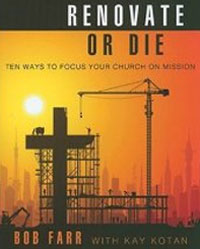Bob Farr offers a generous collection of tools for congregational development in his book Renovate or Die: Ten Ways to Focus Your Church on Mission (Abingdon, 2011). Most of them are borrowed from others, but all of them are stamped from his experiences as a pastor of five vulnerable congregations and as the director of congregational excellence in the Missouri Conference of The United Methodist Church.
If pastoral leaders ignore the “soul” of the congregation — the unique character which Farr has learned to read from years of pastoral experience — renovation is unlikely.
Farr’s leading metaphor is “renovation,” which he describes as “… much more aggressive than redecorating. It is more in depth and has greater personal cost. It is a bit more mysterious because you never know how long it will take, what you will find, what you might need, or where you will end up. One thing always leads to another.”
One of the most appealing aspects of this book is the introduction of that element of mystery into the otherwise pragmatic discussion of renovation by consultation, four-step programs, and slim down exercises. Farr argues that a congregation sometimes, but not always, resists the call or pace of renovation from its own wisdom of shared history, corporate voice, and accrued structures.
Pastoral leaders can change their style of pastoral presence and communication, align staff with the corporate vision, simplify structure, create a climate of continuous learning, or apply any of the other techniques Farr has learned by studying the science of corporate management. But if they ignore the “soul” of the congregation — the unique character which Farr has learned to read from years of pastoral experience — renovation is unlikely. Maybe redecoration, but not renovation.
Bob Farr cares about the 85 percent of churches today that desperately need renovation. He offers a cornucopia of tools to help, cautioning that what works in one context may not in another. Since many of the tools are not new, it is the naming of the mysterious element that lingers after reading this book. What is that mysterious element that Farr has encountered as pastor and consultant?
I have three guesses. 1) It is the “nature and mission” of the church shining through. We are never quite able  to reduce the subject of church to its mission. The character of life together is one side of the equation; being sent out is the other. In the end we need both. 2) It is the rich variety of biblical stories about the people of God shining through. Nehemiah came to mind reading this book. One text in one book (Matthew 28:19-20) will not do; we must attend to the whole counsel of God. 3) It is the priesthood of all believers shining through. As the church continues to grow into this doctrine — a movement surely accelerated in an age of information — the model of shared rather than top-down leadership simply feels more appropriate.
to reduce the subject of church to its mission. The character of life together is one side of the equation; being sent out is the other. In the end we need both. 2) It is the rich variety of biblical stories about the people of God shining through. Nehemiah came to mind reading this book. One text in one book (Matthew 28:19-20) will not do; we must attend to the whole counsel of God. 3) It is the priesthood of all believers shining through. As the church continues to grow into this doctrine — a movement surely accelerated in an age of information — the model of shared rather than top-down leadership simply feels more appropriate.







